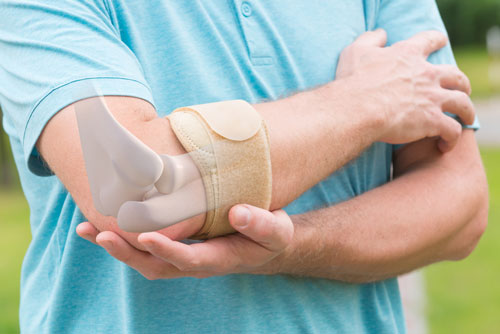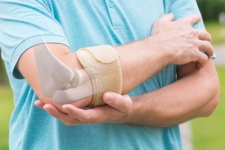
In children, most elbow injuries occur during activities such as sports or play. Contact sports such as football, soccer, and wrestling carry a higher rate of injury, as do high-speed sports like hockey, skiing, snowboarding, and skateboarding. Older adults have a higher risk for injury and fractures due to a loss of muscle mass and bone strength (osteoporosis). A greater propensity for issues with vision and balance also increases the risk of injury.
Acute injuries may be caused by a variety of events, such as twisting, jamming, or bending the elbow incorrectly, or by a direct blow to the joint. Aside from broken bones, sprains (stretching and tearing of ligaments), strains (pulled/overstretched muscles), and dislocations of the joint can all occur.
Injuries caused by overuse occur as a result of too much stress being placed on the joint or other tissue – this is often the result of repetitive action. These type of injuries include:
- Lateral epicondylalgia, aka “tennis elbow”, is a very common injury and is caused by overuse of the forearm muscles, however, it’s not an affliction suffered only by those who play tennis. Swimmers and golfers can be affected as well, as can individuals whose daily activities include work that involves carpentry, plumbing, lifting objects, or even gardening.
- Bursitis, which is the inflammation of a bursa – a small sac of fluid that works to cushion and lubricate an area where tissues (such as tendons, bones, ligaments, muscles, or skin) rub up against one another. Bursitis can be brought on by prolonged or repetitive pressure on a bursa, by activities that require repetitive twisting or rapid joint movement, or by a traumatic injury.
- “Golfers Elbow” – also known as “Little Leaguers Elbow” in children who participate in throwing sports. This type of injury involves soreness or pain along the medial (inner) part of the elbow.
- Pinched nerves, like ulnar nerve compression, occurs typically with repetitive motions and involves a pinching of the nerve near the elbow joint.
Treatment for an elbow injury may involve wearing a brace, physical therapy, splinting and/or casting, medications to treat pain and inflammation, and, in some instances, surgery. Treatment typically depends not only on the location, type, and severity of the injury, but also the age of the injury (did it happen two days ago versus two years ago), as well as your age, health condition, and your daily activities.

